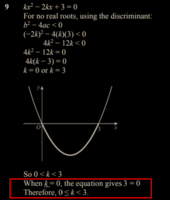johnvedro72
New member
- Joined
- Aug 21, 2020
- Messages
- 3
The question:

The solution:

What I'm stuck on:
So, I've gotten as far as arriving at 0 < k < 3, after using the discriminant to find the values of k, then plotting these values on a quadratic graph and realising that I should produce an inequality that contains all the values between these two roots, however, I'm still unsure of how to arrive at the "0 is less than or equal to k" part of the answer. I've used a red rectangle to outline the part that I don't understand, could someone care to explain it to me? I don't understand why they've plugged 0 into the original equation, or why "the equation gives 3 = 0" validates why k can be equal to 0?
Examboard: AS Pure Mathematics - Edexcel
The solution:

What I'm stuck on:
So, I've gotten as far as arriving at 0 < k < 3, after using the discriminant to find the values of k, then plotting these values on a quadratic graph and realising that I should produce an inequality that contains all the values between these two roots, however, I'm still unsure of how to arrive at the "0 is less than or equal to k" part of the answer. I've used a red rectangle to outline the part that I don't understand, could someone care to explain it to me? I don't understand why they've plugged 0 into the original equation, or why "the equation gives 3 = 0" validates why k can be equal to 0?
Examboard: AS Pure Mathematics - Edexcel
